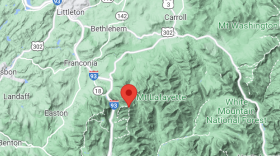Known as the “Birthplace of Freestyle Skiing” Waterville Valley is also credited for having the “First Trail Network in the Nation.”
You can read all about the highs and lows of the town and its trails in the new Waterville Valley Guidebook NHPR’s Sean Hurley went out with the authors to find traces of the area’s history on its 125 miles of trails.
Editor's note: As with all of Sean Hurley's stories, we recommend giving this a listen.
At Livermore Trailhead in Waterville Valley, I meet up with writer/hiker Steve Smith and his collaborators, Dan Newton and Preston Conklin.
“The last history that was written about Waterville was entitled ‘The Town at the End of the Road,'” Smith tells me as we begin our hike, “And that really kind of says it. It's removed. It's not on the main thoroughfares, you know, for driving, and you come here and you stay here and hike.”

Smith suggests we tour along the Livermore Trail, as it’s a path to other paths and the starting point of so many hikes in the valley.
“That's the Kettles Path,” Smith says as we pass it. “That was built around 1890. But it's named for a glacial formation called a kettle hole, where chunks of ice were left behind by the receding glacier.”
If you can make it past the perilous kettles, one of which is a hundred feet deep, Smith jokes, you’ll soon find yourself in one of the best spots in the Valley. The Scaur.
“Yeah,” he says, “Which is a wonderful viewpoint. Apparently Scaur is a Scottish variant of scar. So it's Scaur! More like a Brit thing, Scaur!”

As we pass the Greeley Ponds Trail junction, Smith tells me that those remote ponds are the source of the Mad River - and a little ways down that trail you’ll come upon the path to Goodrich Rock - one of the largest glacial erratics in New Hampshire, he says.
It's a rock so big and inviting that Dan Newton and his trail maintenance team built a ladder to its top.
“You know we built it out of the materials right there from the trees around there,” Newton says, “And you expect it to last around ten years and it’s really doing well.”
The Big Pines Trail is next, which Smith says used to go by another name.
“And it goes down to the bank of the Mad River and there are three huge towering white pines, possibly the biggest pines in the valley. There used to be more because it was originally called the Seven Pines Path, but there aren't seven anymore,” Smith says with a laugh.
Until this point we’ve just been wandering. But Preston Conklin, who helped Smith with the history of the area, would prefer a clearer destination, and picks one while showing me a black and white photo of an old dam.
“So I think we'll walk up toward Swayzetown,” Conklin says, “and this picture is in the guidebook. But that's the dam that was at Swayzetown.”

As we walk towards Swayzetown, Conklin tells me it was named after Ebenezer Swayze who had a farm in these woods in 1840. It was the occasional custom back then to name general areas after people if they lived far enough away from everyone else.
That’s how farmer Rebecca Blanchard got her spot on the old map. “I'm not sure why they chose ‘town’,” Conklin says, “but I kind of like it and they did the same thing for Beckytown named for Rebecca.”
Farming was tough in the Valley, Conklin says, and in the book you can read about the bushels of corn and potatoes and the pounds of wool and butter that successful Waterville Valley farmer Samuel Dolloff produced in 1870 - along with directions to his grave and all that remains of his homestead today - a cellar hole off Old Waterville Road.

We stand together in the leaf covered remains of Swayzetown and Steve Smith begins to spy relics left behind from the old logging camp.
“This is a bedframe from I don't know where the camp itself was located, I mean the actual building,” he says and taps his walking stick against the bedframe. “But they always pick a level spot like this and then have water nearby. You know, Slide Brook is right over there.”
And then he parts a sled-runner from the sticks and uncovers pieces of an old stove and then we’re walking along the mentioned Slide Brook where Smith points out a lone submerged log – all that remains of the massive Swayzetown dam that was once here.
“They did river drives from the 1890s into the 1930s down the Mad River,” Smith says. “Usually they'd cut the pulpwood into four foot lengths. And I guess it was quite a spectacle. And dangerous work, very dangerous. But they would use the dams to build up the water to a certain level and let it go. Whoosh! down they went.”

It’s this intersection of history and trails, of a walkable, somewhat knowable past, that Dan Newton finds so appealing about the new guide book.
“It's got so much information,” Newton says. “I think that's what separates it from the other books is that it's really comprehensive with the history and all the way up to the local skiing, some of the history of the ski area. And then the real heart of it is the trail descriptions.”
In Smith’s Waterville Valley Guidebook, you can read how the people shaped the place and the place, the people. You can read about the Stone Tower that’s still hidden somewhere in the woods, about the big boulders and the mountain flumes and lost trails and fishing spots and the scaur’s across the Valley.
You can see the whole history of a town sparking to life - not in spite of such natural wonders, but because of them.







